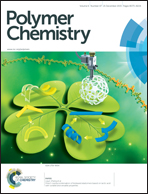A cyclic azobenzenophane-based smart polymer for chiroptical switches†
Abstract
A photoresponsive smart polymer with asymmetric cyclic azobenzenophanes as pendent groups is synthesized for the first time. In the beginning, we pre-surveyed the chiroptical properties of planar chiral azobenzenes (9a, 9b and 9c) with different methylene spacers (n = 2, 6, 11) via experimental and theoretical approaches, finding that the cyclic configuration with six methylene spacers shows interesting chiroptical behavior for oscillating “zero-negative-zero” CD signal changes in the absorption region of the azobenzene segments during the photoisomerization process. And these experimental data were strongly supported by theoretical calculations. Moreover, three functional polymers with different cyclic azobenzenophanes as pendants were prepared and their chiroptical properties were also studied in detail. We found that, unlike the other two polymers derived from 9a or 9c, the unique properties of the cyclic pendants from 9b can effectively transfer to the corresponding polymer (PCM) through the reflection of the specific optical rotation measurements under alternating UV/Vis light irradiation showing no fatigue. This means that the obtained polymeric material PCM is a good candidate for a chiroptical switch based on zero-rotation/levo-rotation.



 Please wait while we load your content...
Please wait while we load your content...